How to build a very cheap house. What material is best for building a house.
Individual construction has become very popular now. Many future property owners prefer to build a house on their own, rather than buying the finished one proposed by the developer. It is believed that it is better and much cheaper.
However, when choosing an economical version of materials for construction, one should not forget about factors such as climate, soil quality, humidity, etc. Otherwise, what you would like to build inexpensively will turn into a deliberately losing and rather ruinous enterprise. So, from what to build a house for permanent residence, so that the construction is inexpensive, and the building stood for many years without complaints from the residents?
Planning
It is important to remember that you can’t save on everything. Savings should be reasonable, not at the expense of quality. This is especially true for construction. Correctly calculate costs will help rational planning. The cost of your future home can be calculated in advance.
At the first stage of planning, you need to consider:
- climate in the locality: the harsher the climatic conditions, the thicker the walls should be and the more thoroughly they need to be insulated;
- soil features: taken into account for the correct choice of the type of foundation;
- characteristics of the terrain: how much it will be necessary to deepen the foundation, etc.
Inexpensive building material may be ideal for areas with a warm climate and hard, rocky soil, but not at all suitable for a humid climate zone with clay soil. If the conditions are severe enough, it is more profitable to immediately buy more expensive and more reliable material than to reap the benefits of inappropriate savings.
Especially you should not buy cheap material when it comes to the foundation of the building. Any builder will say that in this matter it is better not to save at all. According to statistics, during the construction of private houses, almost half of the costs (about 40% of the budget) falls on the foundation.
The construction of the foundation and the material from which it will be created depend not only on the quality of the soil, but also on the number of floors and the total weight of the building. There are certain laws that cannot be violated. For example, a brick building is not recommended to be erected on a foundation of foam blocks. The house will be too heavy for such a fragile foundation.
The final cost of the house can be determined based on the following parameters:
- layout: the right engineering solution can greatly save the budget. The extent to which the usable area of \u200b\u200bthe house is used economically and rationally will determine its final cost;
- building architecture: if you want to build a house inexpensively, do not get carried away with such architectural details as balconies, fancy roof bends, beautiful passages, arches and terraces. All these beauties will cost a lot of money, and our task is to build a house for permanent residence as cheap as possible;
- decoration: ceilings, floors and walls should be finished according to the principle of "reasonable sufficiency". Any excesses are unnecessary expenses that hit the budget very much;
- A reasonable choice of building materials.
The choice of building materials
Experience shows that it is in the wrong choice of building materials that unnecessary expense items often lie. You should not invest too much, but you should not build the walls of your house from cheap "raw materials".
For example, if you are going to cost yourself a house for year-round - permanent - residence, forget about such cheap options as polystyrene blocks. They are suitable only for a very small country house in which the family will spend a couple of summer months.
It is better to use such common options as brick, wooden timber, aerated concrete. Recently, the construction of the so-called "frame" buildings is gaining momentum. The advantages, advantages and disadvantages of all these materials and the price ratio are worth considering in more detail.
Wood
Wood is the most environmentally friendly and warm building material, but alas, not the cheapest. If you want to build a wooden house, but really want to do it as inexpensively as possible, it is better to stay on a wooden beam. Walls made of logs will cost more. The price range is approximately the following:
- round log - 15-16 thousand rubles per square meter. m;
- pine timber - 12 thousand rubles per square meter. m;
- glued timber from pine - 33 thousand rubles per square meter. m
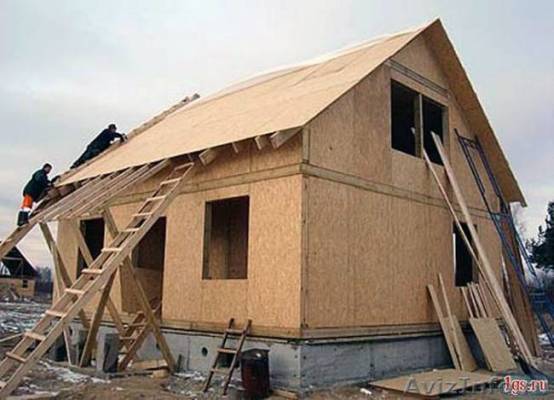
Wood - the material is warm, perfectly stores heat, and therefore does not require additional insulation. The houses built from it have an excellent, very healthy microclimate and even a pleasant smell. The tree "breathes" and does not contain harmful compounds. In addition, for a wooden building, it is not necessary to build some kind of especially fortified foundation. A beam or logs can be used in settlements, which are located in a rather harsh climate.
But these materials also have disadvantages. The wooden structure shrinks for a long time, so you can’t move in immediately and even just start finishing finishing right away. In addition, the wood will need to be protected from pests (woodworms) and treated with flame retardants for fire protection.
Brick
Brick is perhaps the most common and versatile building material. This is due to its excellent qualities and the possibility of application in different latitudes. Not insulated walls made of bricks can be built for about 20-22 thousand rubles per square meter. m. But this does not mean that they do not need to be insulated! Look at the diagram of how this work is done.
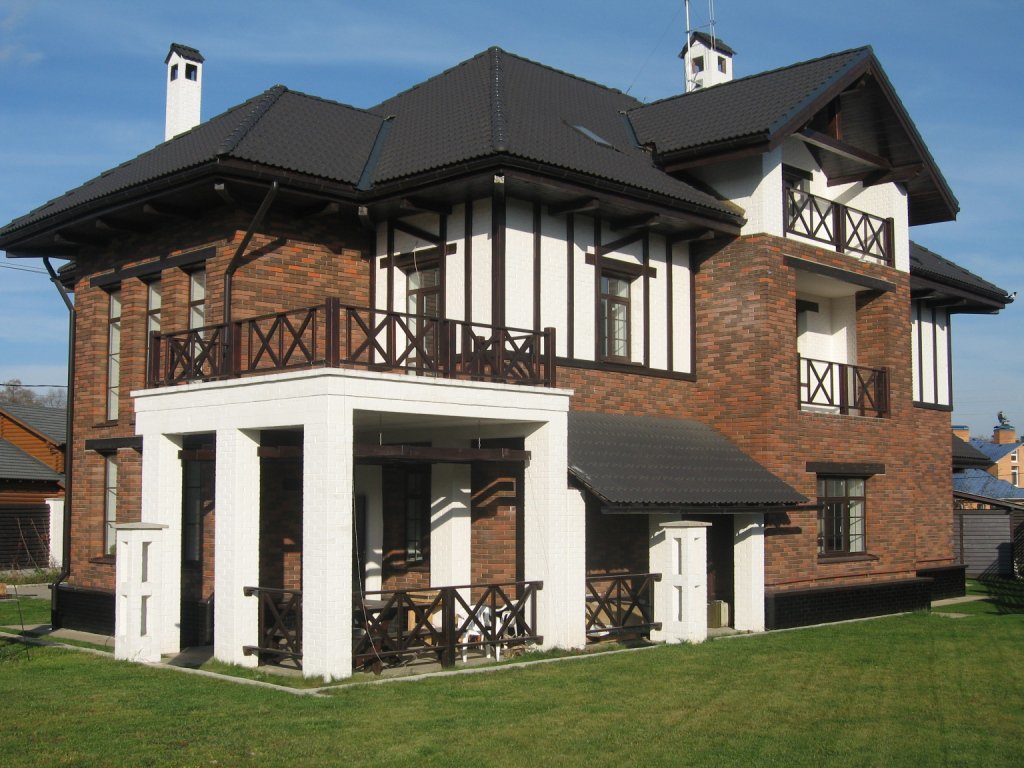
The advantages of brick include the following:
- this material is very durable;
- walls made of bricks do not rot;
— floor floors can be made of reinforced concrete slabs (this is a common practice).
But the brick has obvious disadvantages. The most important is the high cost. If you want to build a house as cheap as possible, build brick walls - not the best option. The brick building is very heavy, so a powerful foundation is required. This should be especially taken into account if there are problems with the soil.
You will not be able to make construction cheaper by saving on wage labor. High-quality laying can only be done by a qualified specialist, and the entire construction process will take a lot of time. So a brick house is reliable and of high quality, but long and expensive.
Aerated concrete
Aerated concrete (or cellular concrete) is a relatively new word in individual construction. This is exactly the option when construction can actually be done cheaper. Compared to brick and glued beams, cellular concrete is quite inexpensive, but at the same time it is of high quality. Sq cost meter of material - about 15 thousand rubles.
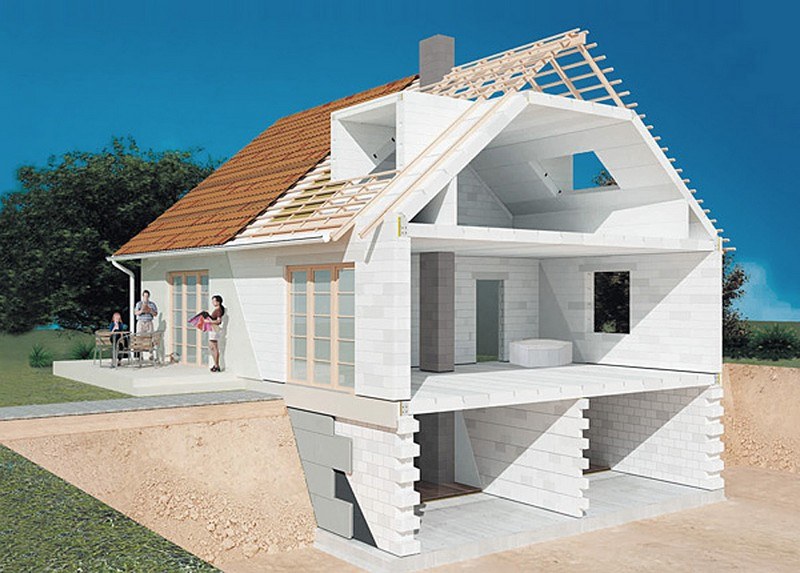
Aerated concrete is a very warm building material. You can not insulate it at all, but the walls in this case are better to make thicker. Otherwise, you can do with a layer of mineral wool. Exterior finish can be made of brick or decorative facing stone.
Installation of aerated concrete is quite simple. With some experience in construction, it can even be done independently. Aerated concrete is lightweight, so it does not need a powerful foundation. This will also make construction much cheaper. The walls of the foam blocks do not rot, so they do not need any special processing. Yes, and you can build a building from this material quite quickly and efficiently.
The disadvantages include the need for very high-quality waterproofing. The second disadvantage of aerated concrete is its relative fragility. The walls of this building material will not withstand heavy loads. Optimal are one-two-story structures. If you are going to build a 5-story building, it is better to use a brick and make a solid foundation for it.
Frame houses
According to many characteristics, frame buildings are similar to wooden, but do not have the strength of wood. This type of structure is best to choose if you live in a warm climate and want to save as much as possible. Sq minimal material meter - about 11 thousand rubles.

Build frame house You can do it yourself. The foundation for a frame building is also lightweight, and the construction itself will move quickly. Unfortunately, frame houses - not the most durable designs. If natural disasters occur in your area, it is better to forget about such a cheap option for building a house. Otherwise, you risk remaining after the first hurricane or earthquake without a roof over your head.
These are the main advantages and disadvantages of these materials. Which one is better and how high quality the construction will be completed as a result is up to you. And do not forget that when calculating the cost, you need to take into account the prices of waterproofing, insulation and exterior wall decoration.
Those who wish to settle outside the city or in a small village all arrive. In megacities it is stuffy, morally and physically, from inhaled air and extraneous noise. I would like, if not at all to evict, then to acquire a corner of outdoor recreation. We know that we do not suffer from excess cash, so the challenge is: how to build a house inexpensively? In a private house, you will have to work harder about the housework and its maintenance will cost a little more than paying a communal apartment for a city apartment of equal area, but a healthy lifestyle is worth it. And if you start at least a small personal garden garden with a greenhouse, then, without straining, individual housing can be made profitable in general.
Is it cheap fast?
A private residential house of the budget price segment may well be convenient, warm, reliable. And if the hands grow as they should and there is a desire to attach them correctly, then they look solid, see fig. However, building a house cheaply is not everything. The people on Earth are already almost 7.5 billion and everything is arriving. Our "ball" is not rubber, so it would be naive to expect that property taxes and land rents would somehow decrease there over time.

Therefore the most cheap house not necessarily the one whose construction will cost less: when choosing material for the house (see below), a project, etc., it is imperative to keep in mind further operating costs. Especially if the construction is carried out on credit, you need to start giving it away right away. That is, the period from the start of construction to the readiness of the house to move in is of great importance: while construction is underway, it will not be until additional income is sought, but you need to pay for the previous housing and take out the next loan payment.
The conclusion is obvious: Having decided to build, first of all we are wondering - how much will we eat until the house is completely ready? This point may turn out to be significant even for a fairly experienced builder, if you need to decide whether to do it yourself or entrust some stage of construction to a bona fide contractor with well-established production and well-equipped technically. The savings from a reasonable distribution of cash and / or available funds at the stages of home readiness (see below) for contracting and own-hand work can significantly exceed all other possible articles and will certainly make it much easier and easier to choose the basic structural material of the house and its foundation - the foundation.
What is a budget house?
We will consider the house to be budgetary, the construction of which is fully prepared (see below), but without heating, cooking and plumbing fixtures, it will cost 10,000 rubles. for 1 square. m of total area or less. A house with 100 square meters in total in this case will cost up to 1 million rubles. or approx. $ 18,000 at today's rate (2017). In certain local conditions it is possible to reduce the cost of construction to 5500-6000 rubles. per square; if you build completely with your own hands slowly only for your own; if there is a low-cost old housing, then it is possible to meet 4500 rubles. per square, but cheaper it is already a fiction, no matter who promises. Good contractors for 3,000 rubles. for a square you can still find, but on a turn-key basis, and to bring the house to full readiness will require at least as many more.
Note: the figures given, as well as the further ones in this article, are average for the Russian Federation. Here it is appropriate to recall the old joke, which is now in its own way rewritten in almost all countries: the nobleman eats meat, the peasant only has enough for bread. On average, they eat meat pie for two. So finally look at the prices at home - it is impossible to give a full review of them in one publication, and the market situation may change tomorrow after its publication. We here mainly give information on how to build a house cheaply and quickly without technical and organizational measures, without detriment to its quality.
About number of storeys
The problem of taxes and land rents can be largely solved, firstly, by building a two-story house, which will save on land costs. Some prejudice against the upper floors in individual homes Remained from Soviet times, when it was strictly forbidden to build privately in more than 1.5 floors. Build a budget 3-storey no longer makes sense: you will have to give too much usable area to the stairwell, and strengthen the walls of the 1st floor, which will greatly complicate, lengthen and cost up work. And in the 2-story staircase to the 2nd bedroom, the floor can lead directly from the living room or hallway / hall.
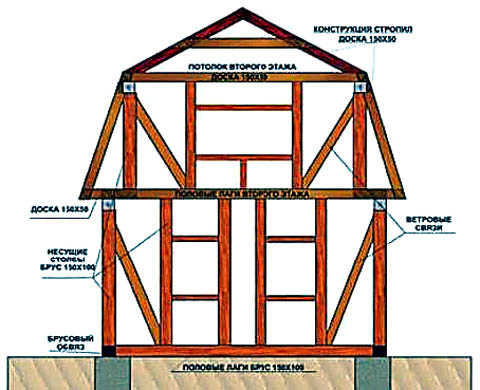
Secondly, real estate tax can also be significantly knocked off on the very legitimate basis by completing a sleeping half-floor in the form of a Siberian attic. The scheme of the pediment of a frame residential building with a Siberian attic is given in Fig. on right. Not everyone likes houses with Siberian attics because of the faceted roof, but in reality they are economical and convenient, and in budget construction there is no time for exquisite architectural solutions. For a budget frame house (see below), the Siberian attic is practically the only way to increase its actual number of storeys.
Note: for a house of foam or gas blocks, there is another non-trivial possibility of increasing its living area without a significant increase in taxation and land rent, see below. This factor may turn out to be decisive in regions where 2 or more floor individual construction is prohibited due to natural conditions, e.g. in seismically dangerous places or in permafrost.
Stages of home readiness
By the stage (stage) of the readiness of a residential building for occupation is meant a completely completed cycle / complex construction workafter which the structure can wait for the beginning of the next stage for a certain definite or indefinitely long time. A technological break between the stages is most often necessary to shrink the structures of the previous cycle, but sometimes (see below) is unacceptable or possible only in the warm dry season. Work at the next stage of construction can be carried out both independently and in a contract from the same or another contractor, regardless of how the previous one was performed. The stages of bringing to the readiness of a budget residential building are as follows:
- Zero, or zero cycle - the foundation was laid, gained at least 75% of the strength and gave a settlement draft. This is the most responsible, complex and time-consuming stage, at which it most often turns out to be expedient to hire an experienced brigade in a contract. Technical break before the trail. stage is necessary in any case.
- Box - there are walls with openings for windows and doors, covered with a roof. Supporting partitions are also built inside. Communications failed, but so far muffled. A mandatory technical break is required only for heavy (brick, stone, concrete) buildings, on their own shrinkage. In budget construction, the box stage as such is most often not allocated, and for the house it is generally excluded from SIP panels.
- Turnkey - doors and windows in place, the box is steady. A house can overwinter up to several times. It is possible that floors are also laid, but the communications are not divorced, there is no interior decoration or insulation. A favorite bait of unnecessarily ingenious contractors "for cheapness", so at this stage you need to especially carefully consider how much it will take for you to eat for the rest of the work, as well as their cost, and compare with the price of bringing the house to full readiness by employees.
- Full - communications are divorced, stationary household appliances in the field and ready for use. The interior decoration is done, but the exterior and insulation may not be provided for by the terms of the contract (see below). The kitchen, bathroom and boiler / furnace are fully equipped, you can cook, wash, start the boiler and heat. It remains to bring in and arrange furniture, lay carpets, hang curtains, paintings, arrange trinkets, etc., so that you can live in the house - not to bother.
About contractors
A conscientious contractor, firstly, must be properly legalized - as an individual entrepreneur, LLC, etc. accordingly, it should immediately, without reminder, present to the customer a package of documents confirming state registration. Special licenses for ordinary construction work are not required, enough professional certificates ("crusts"; now - cards) of executing workers.Secondly, the customer should be offered a paper contract. An offer (public type) or individual, it does not matter, most importantly, the rights and obligations of the parties should be clearly stated there. Thirdly, there should be indicated warranty period at this stage (stages) of work and conditions for observing warranty obligations.
Good contractors on the "budget" give a guarantee of 2-5 years. Less is not possible due to technical breaks. More honestly, too, is impossible, because the local operating conditions of the building may change for the worse. They can be taken into account (“built in” constructively) by using more expensive materials and technical solutions, but this will no longer be a budget construction.
About extensions
In the popular sources and prospectuses of the contractors, one’s mind can find recommendations accompanied by outline (without reference to the place) projects: they say, we first build a 6x9 house very cheaply, and then, as we accumulate funds, attach more rooms to it (the initial layout allows), while children and grandchildren will not remain a huge mansion. This approach is fundamentally wrong.
Anyone who is more or less familiar with construction knows that the extension of a residential building to the existing one is a complex and not always feasible technical task. First, the old foundation is already completely donkey, and the new one will give the design shrinkage only under the weight of the bearing structure. That is, the extension can not be immediately attached tightly to the main structure, you need to wait for the cracks to go, and close them. It is difficult to find publicly available information about extensions to existing buildings in a common runet; You can search for a small but sensible little book of Dr. tech. of sciences Ferenza Sagi "How to avoid mistakes in the construction of an individual house." There was a Russian translation, M., Stroyizdat, 1987. Curious - this book was then worth as much as 90 kopecks. Soviet.
Third, even if the house is rubber on a gimbal, letting it swing from year to year and swinging in time with the seasonal movement of the soil is unacceptable. A kind of virtual (invisible) warm “pit” is formed under the house, built on a correctly selected and laid foundation, in which it is never below zero; the blind area around the house expands it to the sides. An extension to the house may upset the established heat balance of bearing soil, which is fraught with accidents of the main building. Therefore, bona fide contractors set out one of the conditions of the guarantee - no extensions that are not consistent with them.
Garage in the house, or the role of planning
One of the ways to get an inexpensive house with respect to the available living space for a permanent residence is to build a house on a common foundation with a garage. Perhaps this is only for houses made of non-combustible materials; regarding budgetary - foam and gas blocks, otherwise firefighters will not allow to approve the project or legitimize the unauthorized construction.

However, simply attaching the garage to the house, as on the left in the figure, does not make much sense, it will do little to save construction costs and further maintenance of the house. It is necessary to introduce a garage of a standard size 4X7 m inside into the structural diagram of the house, taking into account the following:
- there is no need to put the garage on the basement, because then you will have to fence an access ramp to it;
- the ceiling height in the garage is permissible 2.5 and even 2.2 m, less is simply impossible;
- it is highly desirable to have an entrance to the garage from the house, but then it is only permissible from the hallway / hall and should be with a vapor-proof fireproof door.
In this case, the garage floor slab will serve as the floor of one and a half floors, less taxed, but quite spacious. An example of such a layout is shown on the right in Fig. The utilization of the area there is not so hot, but there are a lot of amenities:
- One and a half superstructure is not an extension, no special measures are required for its construction on an existing well-established building, i.e. you can build up on the garage and then, as the family grows.
- The staircase to the one and a half floor turns out to be low and fits into the existing hall without any special difficulties.
- Garage heating is also arranged without problems, moreover economically, because it is a little heated from the hall and the kitchen.
- In the lobby of the 1.5th floor under the ceiling, the pressure tank of the autonomous water supply is perfectly placed; there you can move the dressing room, increasing the area of \u200b\u200bthe living room and bathroom.
- Since the floor of the bedroom is heated to some extent, in turn, from the garage, it can be done in a rather harsh climate with a French window.
- One basement wall is common with a garage. Communications are, of course, established in the basement. That is, a sewer riser can go from the bedroom to the basement, to which a wash basin, shower and even a jacuzzi are connected upstairs.
- The passage to the basement is also internal, through a hatch in the lobby or from the garage.
Agree, a house for 4-5 people with a separate dressing room, a living room of more than 25 squares and a French bedroom, in which also a hydromassage, is really really cool. And the total area on earth is much less than 180 square meters. m, which begins with increased taxation. Even if in your country the basic area norm is 150-160 sq. m, the tax authorities will still have to burn the house budget.
Foundation and ground
Choosing the foundation of the house or checking the option proposed by the contractor, it is necessary to conform to the geology and soil mechanics at the construction site. The factors of soil mobility, most affecting the cost of the foundation of the house, are as follows:
- Load bearing capacity.
- The degree of heaving (the value of frost heaving).
- Regulatory freezing depth (NGF).
- The highest standing groundwater.
Bearing capacity and heaving
Mass low-cost development is possible on non-porous and slightly porous soil with bearing capacity up to 0.7 kg / sq. cm, but only according to the results of careful preliminary surveys over the entire built-up area with a decent margin at the edges. An experienced contractor can build a separate reliable house on medium-grained soil with a bearing capacity of 1.1-1.3 kg / sq. m. Self-construction can be done on the ground to medium-grained with a normal bearing capacity of 1.7 kg / sq. cm or higher. On strongly and overly porous soils, budget development is not possible with rare exceptions (see below).
Note: the bearing capacity of the soil directly at the construction site can be determined on its own without complex devices, but how - this is a special article.
NGP and groundwater
Some potentially budget houses should not be erected on an unfinished foundation (see below). The heel (sole) of the foundation should be buried below the GHP by at least 0.6 m on medium-to-gravel soils and not less than 0.3 m on slightly heaving and non-gravel. The bottom of the foundation should not reach 0.5 m or more to the level of standing groundwater. Typical extreme cases for budget development: dry sandy loam (slightly heaving), oil and gas production 1.5 m, standing water 2.5 m; foundation deepening is 1.8-1.9 m. Or - moderately moistened podzol (medium-grained), oil and gas concentration 1.2 m, water standing 3.5 m. Foundation deepening from 1.8 m.
What if a fire?
The question of which it will be cheaper to build a house in a given place must be decided without fail, taking into account the fire hazard. Hoping for the best, preparing for the worst is a universal principle, and the harmfulness (or coercion) of firefighters is here in fifth or seventh place after their own safety. Regarding the possible harm from a fire, the properties of materials for budget construction are divided. way:
- Fire safety (this is not the antipode of fire hazard) - how difficult it is to set fire to a given material and whether it is able to burn outside a fire. In fact, is it possible to extinguish a detected sunburn in a timely manner with improvised means without significant damage to the building structure.
- Fire resistance - how long the material is able to resist fire without losing mechanical properties until the structure collapses and / or without emitting toxic gases. In fact - how much time do you have, if extinguishing on your own is impossible, to evacuate and take out the property.
- Fire resistance - how much, having been on fire for at least 20 minutes, the material restores its properties. In fact - suddenly the box of the house completely burned out, is it possible to equip it again with housing.
Materials
So the time has come to choose material for the house of a budget price category. Houses made of bricks, professional timber and logs chamber drying from the budget category, unfortunately, are excluded. They have a lot of advantages and relatively few drawbacks, but it will be possible to move into a brick house no earlier than the 3rd year from the beginning of zero: a year for shrinkage of an expensive buried foundation, a year for shrinkage of a box, and only then you can turnkey, plus time for internal finish. In addition, at current energy prices brick house expensive external insulation is necessary.
Note: houses made of wood concrete (fiber concrete), reed, straw blocks, etc. not considered because their reliability has not yet been confirmed by time and there is no established construction industry for their construction.
Chamber profiled beam and log, impregnated with harmless antiseptics and flame retardants, are roads in themselves and require a solid carpentry experience for building a residential building. The houses of them are considered prestigious; as a result, the cost of work is high. Prefabricated-panel houses do not fit into the budget category either: they are being built very quickly, but their construction requires qualified personnel and a high degree of mechanization of work. Given these circumstances, the choice of widely available materials is rather limited. To compare the cost of a fully finished house per unit (100%), you can take a frame house from non-glued timber and a conventional air-drying board. The result looks like a trace. way:
- Country wooden frame house only from the board - 0.6-0.8
- House on a steel thin-walled frame - 0.85-0.9.
- Residential wooden frame house of timber and plank - 1.00.
- A timber house from an ordinary air-dried timber - 1.4-1.8.
- The house from SIP panels - 1.9-2.00.
- House of foam or gas blocks - 2.00-2.15.
Frameworks and timber
Common advantages and - low sensitivity to soil movements, they "play" with it. Therefore, it is possible to build such houses on a shallow column foundation, the simplest and cheapest. It is possible to build a residential frame / timber budget house also on heavily fenced, soft soil, laying a pile under it strip foundation TISE. A 2-storey frame house cannot be built without a detailed project, but in budget construction this problem is solved by the Siberian attic, see above.
A timber house is good because in regions with a fairly mild winter it does not require additional insulation: a timber 200 mm thick is equivalent to 600 mm brickwork. The inner cladding in both a timber and a frame house is possible with plywood or non-combustible materials: particleboard, OSB. Exterior OSB cladding (Oriented Strand Board, OSB, Oriented Strand Board) will give the house additional rigidity in the wind and weather resistance. The plaster inside there and there is dry, drywall (gypsum plasterboard) on a groove (15-20) x40 mm; It is impossible to sheathe GCR without a lathing even completely even walls.
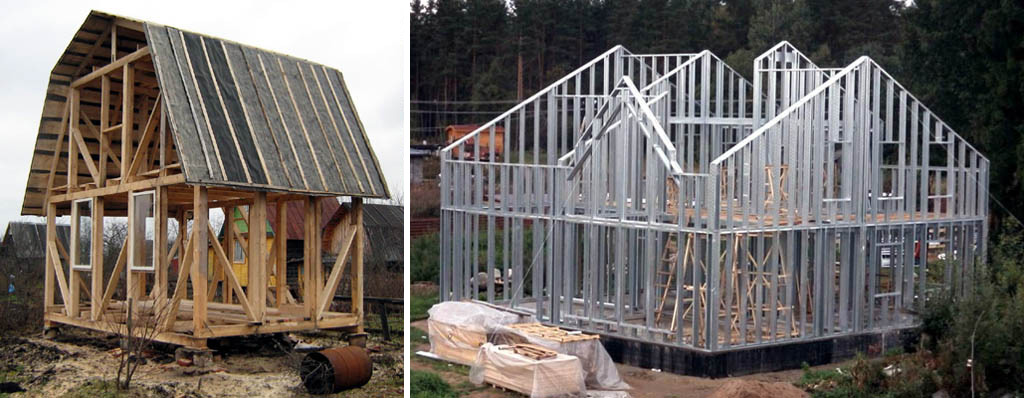
The design of the wooden frame house is well known (on the left in the figure). Without impregnation with biocides and flame retardants (which can be done independently), all the fire-fighting qualities of such houses are low, and fire resistance is generally zero, they burn out completely. Fire safety and fire resistance can be increased to acceptable (10-15 minutes for evacuation), if the insulation is made with ecowool (cellulose insulation). It will cost approx. 25% more expensive than mineral wool, but ecowool, when heated, emits a lot of water vapor that delays the fire. In addition, ecowool does not rot wood: it contains an antiseptic - borax. Wet ecowool does not subside and retains 75% of the warming qualities, and dried out completely restores them. Ecowool insulation is possible manually without experience; any fasteners and lathing are not required. Waterproofing and vapor barrier for ecowool need inexpensive simplified ones. The estimated service life of a solid-wood frame or timber house with thermal insulation of mineral wool and without external cladding is 25-40 years, depending on the quality of the wood and local conditions; the same with ecowool insulation - up to 70 years or more.
Inexpensive house for a summer house of frame construction with a size of approx. up to 4x6 m it is possible to build from boards alone with no hands, without experience, as well as airborne timber drying. But if the total area of \u200b\u200bthe house exceeds approx. 25 sq. m and / or the number of openings in it is more than 3-4, an experienced carpenter must build. In this case, the frame of the house is needed with the main load-bearing elements made of timber from 150x150 mm.
The first is to have openings of windows and doors in the house, any size of which exceeds 6 m, anyhow it is impossible. Computer programs do not help much here: you need to enter the initial data into them and choose a calculation method based on your own experience. There is no computer construction program that would “do everything by itself” yet.
The second - in a residential frame / timber house there must be at least two load-bearing partitions. Their location can be taken from a standard project, but it is unlikely that a beginner will be able to properly connect the partitions to the external walls; especially if the house is timber.
In a timber house built without experience, there may also be a caulk problem. Only a very experienced specialist can reject a timber that is highly prone to warping upon purchase. If the seasonal summer house splits, the trouble is small, you can simply plug the gaps. In a large residential building with split walls, it will be possible to survive 1-2 winters, spending a lot on heating, and then it will quickly go to accident due to weakening of the structure.
Houses on a steel thin-walled frame (on the right in the figure) may be somewhat cheaper than solid-wood, but this is an apparent cheapness. The main thing is that the fire resistance of houses on a steel thin-walled frame is zero: in a flame, the frame instantly (in less than 3 minutes) loses its strength, and the house collapses. In addition, it is very difficult to take into account the fatigue of elements of a complex thin-walled structure, and there are not a few cases of sudden collapse of such houses for no apparent reason. In general, the operating life periods declared by manufacturers of 100-120 years are not maintained, therefore, in some states, only non-residential small architectural forms are allowed to be built on a steel frame.
SIP
Structurally insulated panel (SIP, SIP, Structural Insulated Panel) is a pie made of plywood or OSB boards with extruded polystyrene foam (EPS) or polyurethane foam between them. For residential construction suitable SIP from OSB and polyurethane foam; SIP in the filler from EPSS in the fire emit a huge amount of toxic gases. The main advantages of houses from SIW, firstly, the speed and simplicity of construction, see video:
Video: an example of building a house from SIP
Even more reduces the time to bring a home from SIW to readiness for introduction that they can be built on an unfinished foundation such as a Swedish or Finnish stove. These foundations are cheap, the term for their "maturing" fits in the warm season, so the slab foundation for a house from SIW can be ordered / laid with a margin for future outbuildings or for an extensive veranda, see Fig. on right. The external decoration of the house from SIP can be any and it will look more than decent, see ibid.
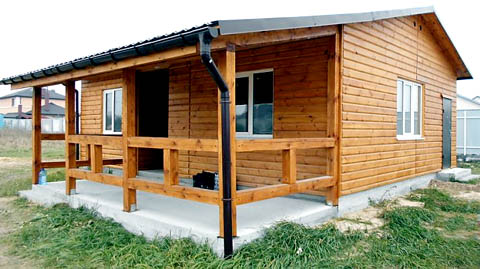
It is equally important that the self-supporting insulated wires themselves are an excellent heat insulator and no additional insulation is required from the house. The disadvantages of SIP-houses include the need for a ventilation system, as walls do not breathe. In Russian conditions, it is significant that SIW houses are unsuitable for stove heating, the panel filler heats up and gradually exudes toxic substances. The service life of the self-supporting insulated wire manufacturers also declare a small, 40-70 years. Finally, the box of self-supporting insulated wires should not be left to winter, the house should be built at least on a turn-key basis during the warm season.
Air blocks and gas blocks
A box can be very inexpensively engaged in construction on weekends, stacked from spring to late summer on glue, without being a mason at all; she can winter once under the roof and wrapped in a film. A technical break for shrinkage of the box is not needed.
The main enemies of the foam / gas block house, firstly, moisture. There is plenty of pore for condensation in its walls, and a damp house made of foam / gas blocks is difficult to dry for a long time. Therefore, in this case, a complete (and not cheap) vapor barrier is required both outside and inside (there are household fumes and breathing) and good external thermal insulation that does not “let” the dew point into the walls. As a result, the statement that the house of foam / gas blocks is breathing is, to put it mildly, just talking. Who lived in such a house is unlikely to argue.
In fact, the only way to 100% prevent damping of a house from foam / gas blocks in any conditions is a ventilated facade. Which acts great, but does not apply to budget construction. Comfortable and even luxury houses made of foam / gas blocks can be built and are being built, but in warm places and not in the budget segment.
The second enemy of the foam / gas block house is the natural deterioration of concrete. Suppose he crashes only 0.01 mm per year. In this case, 300-400 years will pass before the reinforcement is exposed in the concrete monolith, which can be ignored in the calculations of ordinary buildings. But the partitions between the pores of the foam / gas blocks are of the order of 1 mm, and their safety factor of 100% will be exhausted in 20-25 years, because destruction comes from 2 sides. Therefore, the estimated service life of a house from foam blocks or gas blocks up to 60-100 years is clearly exaggerated. Confirmation of this is the massive (and unsuccessful) sale of aerated concrete villas in Spain not even at cost minus depreciation, but for how much they will take. When building, they forgot about the micro wear of the blocks, and now what to do with all this?
To summarize
So, in accordance with all the attendant circumstances, we have few options for really budget construction:
- The main one is a solid-wood frame house insulated with ecowool.
- Additional under autonomous heating from the boiler or underfloor heating - a house from self-supporting insulated wires.
- The same, on stable soils in places of consistently dry, warm and with long summers - a house of foam blocks or gas blocks.
If the payment on the mortgage is reduced to 6-7%, then, perhaps, prefabricated panel houses will come in first place. In the meantime, any of those that we have come to, with proper execution and construction in suitable conditions, is able to provide 2 generations with comfortable living. It’s better not to count on more from budget construction.
The question of how to build a cheap house and from which it is cheaper to build a house will never lose its relevance. As practical experience shows, each builder can master several tricks, thanks to which you can optimize the progress of work, getting a warm, reliable and spacious housing.
It is impossible to build a cheap house without a thorough study of the preparatory phase.
The cost of construction should take into account the preparation of the house for operation: the arrangement of heating, water supply, sewage, electrical wiring, interior decoration
The wizard will have to implement the specified range of work:
- choice of layout of the house. What is cheaper to build a one-story and two-storey house? It’s easier, faster, more economical to build a building on one floor. It can be a garden house or a full house for permanent residence;
- obtaining a building permit;
- project development;
- logistics (transportation of building materials, warehousing);
- drawing up a site plan taking into account the location of utilities, water supply places.
The choice of material for the walls
Before you build an inexpensive house, you should decide what the walls will be built from. Their design features, thickness, type of bearing base depend on this.
 What can you build a house yourself from? If you conduct a simple analysis, you can understand that the most profitable material is concrete, including block cellular materials, - from them you can build a solid garden, rural or country house.
What can you build a house yourself from? If you conduct a simple analysis, you can understand that the most profitable material is concrete, including block cellular materials, - from them you can build a solid garden, rural or country house.
The final decision regarding what it is cheaper to build a house from is made on the basis of design decisions, the use of removable / non-removable formwork, etc. It can be monolithic concrete, foam concrete block, gas block, ceramic block, wood concrete, sawdust concrete.
The choice of the type of bearing base
How to build an inexpensive house with your own hands? The most economical foundation - monolithic, tape, shallow. Instead of cold basement being built ground floor, which houses all the technical equipment of the future home.
The reinforced support base of the tape type is laid to a depth of 1.0 m, 0.7 m wide, 0.5 m high, 10 * 10 m in size. This is how you can build a cheap house with your own hands.
By the way, despite the cost-effectiveness of such technology, it’s not worth saving on concrete. It must be solid material. You can get financial benefits by correctly choosing the components of the mixture and the method of their delivery to the facility.
The most economical insulation is mineral wool, however, the material is characterized by low environmental friendliness. For wall insulation, it is recommended to use expanded polystyrene
The cheapest way to build a house with your own hands is a rational approach to the choice of materials. You can visit the nearby abandoned quarries, evaluate the possibility of sampling sand, rubble stone. If there is transport, bring materials to the site yourself.
It is profitable to buy cement not in bags, but at a wholesale price. Accordingly, the question arises of its storage. Again, at the place of work, you can build a metal container of 10 cubes, using improvised material and a simple welding machine. Inside the bunker is coated with bitumen mastic, which will save the material from the rain.
Any supplier will gladly fill this tank. How to build the cheapest house with your own hands? It is better to buy in the spring, before the seasonal price increase has begun. If after construction there are leftovers with joy, neighbors will gladly buy them out - to whom a bucket, to whom a ton.
When deciding on how to build a cheap house yourself, you should choose the formwork material. An inexpensive option is lumber. Edged board is available at any base at affordable prices.
Walling
 Having chosen the material from which it is simple and easy to fold the walls with your own hands, you can begin construction. In fairness, it is worth noting that it is easiest to masonry from block material. Themselves modules can be made independently by vibrocasting technology. The method does not require the mandatory purchase of equipment, - a vibration table, forms can be made with your own hands.
Having chosen the material from which it is simple and easy to fold the walls with your own hands, you can begin construction. In fairness, it is worth noting that it is easiest to masonry from block material. Themselves modules can be made independently by vibrocasting technology. The method does not require the mandatory purchase of equipment, - a vibration table, forms can be made with your own hands.
How to build a house cheaply? You can consider the technology of cast concrete, using expanded clay, sawdust, etc. Cost-effectiveness of construction can be estimated based on the cost of materials in a particular region. Somewhere cheaper to buy shavings, sawdust, somewhere - expanded clay.
How to build the cheapest house yourself - the choice of floors
If you want to build an inexpensive house yourself, it must be borne in mind that the heavier the floors, the stronger the load-bearing wall structures should be. The choice may be towards wood or metal beams. With a competent approach to business it is more rational to use beams from an I-beam welded from a bent profile 60 * 60 * 3 mm, standard reinforcement, pouring from concrete or expanded clay concrete.
Roof construction
When calculating the cost of construction, do not forget about the costs of paints and varnishes, fasteners, primers, sealants and other related materials
To build a house cheaply do it yourself design the simplest form of the roof, for example, gable. As roofing materials use asbestos-cement sheets (slate), corrugated board or roll materials. Installation of a more complex roof, for example, from tiles, can be complicated in the absence of appropriate skills. It is better to entrust such works to professionals, which will cause additional costs.
The choice of interior partitions
Interior partitions can be sliding and stationary. How to inexpensively build a house yourself? It is easier and more cost-effective to build partitions from wood, drywall, and cellular concrete. The design is easily erected independently.
Floor coverings and flooring
This stage of work begins after the walls, floors, roof are ready. To save the floor, it is equipped on the ground with the use of waterproofing materials and insulation. The floor can be wooden, bulk, - in a private house any solution is appropriate.
Window constructions and doors
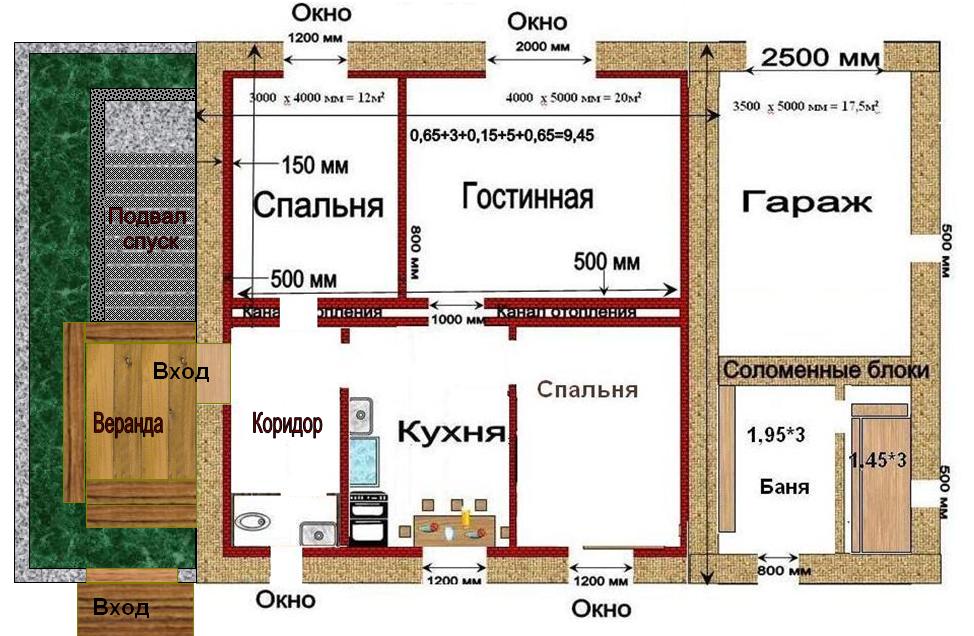
How to build a house cheap? The cheapest way to build a house involves the arrangement of simple wooden or plastic windows. Each type has its own disadvantages and advantages. The main thing is that the premises should be provided with sufficient lighting. Similar materials are used for arranging interior and exterior doors. In the latter case, the product can be coated with sheet metal.
Selection of tools and equipment
How to build a house inexpensively and quickly? Tools and equipment will allow optimizing the progress of work, some of which can be assembled independently, and some can be leased or borrowed from acquaintances.
How to build a house cheaply and quickly yourself? In private construction, you can not do without:
- concrete mixers. An indispensable device on the site, allowing you to build a foundation, walls, floors, floors, screeds, and subsequently ensure the improvement of the site. The drum capacity should be 80-90 liters. The product can be assembled independently from scraps of sheet metal, old mechanisms;
- cutting machine. You can also assemble the device yourself. The optimum diameter of the disc is up to 400 mm. The finished machine will allow you to cut metal, wood, which is relevant at any stage of work and with the subsequent development and improvement of the site;
- yamobur. Any holes that need to be developed in the ground are easily realized with the help of this simple device. How to build a country house cheap? It is enough to do all the work yourself. Yamobur is useful in the construction of the supporting base, fence, shed, etc.
A well-designed project with reference to the terrain and taking into account all the characteristics of the finished housing will ensure long-term and safe operation of the building. This is not a cost item to save on.
How to build a house inexpensively, prices
If it is necessary to solve the question of how cheap it is to build a house from blocks, how cheap it is to build from foam blocks, or how to build a frame version cheaply, the prices for the implementation of all the work are made up of many factors. However, practice shows that the simplest project can be implemented at a cost of 15 tr / m².
Consumption of building materials
How to build a home is very cheap, from which to build a veranda for a house cheap? It is important for a private builder not only to choose materials, but also to take into account the consumption rates of building materials. This applies to each stage of work: foundations, bearing walls and frames, facade, interior decoration, roofing, floors, painting and cladding.
How to cheaply build an inexpensive house with your own hands is shown in the video:
The question of which house to build the cheapest is of concern to every private developer. The maximum benefit can be derived if land plot already owned or there is an opportunity to purchase it relatively inexpensively. Otherwise, you can refer to the recommendations below.
Omitting issues related to the purchase of land, the cost of building their own housing The following factors affect:
- architectural and planning decisions. The developer must understand that even low-cost housing must be modern, convenient, functional;
- constructive building solutions. It is advisable to exclude architectural excesses, the design of the house should be as simple as possible;
- the cost of materials and work. Saving does not exclude high technological work and the quality of the materials used. The construction project can be implemented independently or with the involvement of a team consisting of 2-3 people, which slightly affects the cost of work.
Any project taken on the Internet can be modernized by turning a stone into a wireframe and vice versa. However, such manipulations should become a document of professionals - they do not save here
Do-it-yourself home building - what to consider in a project
The cost of construction depends on the total area of \u200b\u200bfuture housing. It is optimal to lay the dimensions of 9 * 6 m, where 2-3 living rooms will be successfully located.
An example of architectural and planning solutions:
- the basic principle is the minimum ratio of total area to usable, without loss of convenience for living. Simply put, you need to build a house inexpensively "turnkey" so that it was comfortable to be in;
- the effective layout is the presence of two bedrooms, an area of \u200b\u200b9-10 m², a combined bathroom - 3-4 m², an entrance hall combined with a vestibule - 3 m², a living room combined with a kitchen area - 25-26 m²;
- thus, the total area of \u200b\u200bhousing will be 52-54 m², with a useful area of \u200b\u200bat least 50 m², which is 96%;
- the house should not equip pantries. On the plot you can erect a number of additional buildings, which will fill this gap;
- similar projects can be found on the Internet and become familiar with them in more detail.
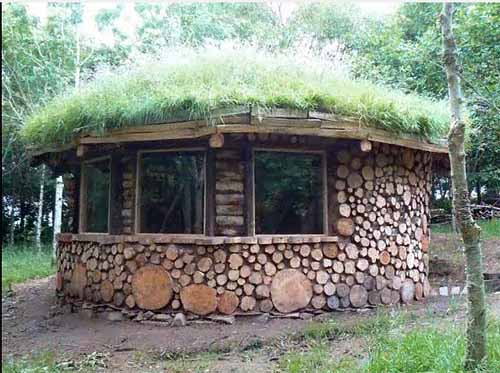 Which house is cheaper to build a one-story or two-story? Undoubtedly, the construction of a typical building on one floor is less costly. However, this solution is less profitable. With a similar area, it is more advisable to build a two-story house (for example, 2 floors of 50 m², than 1 floor of 100 m²).
Which house is cheaper to build a one-story or two-story? Undoubtedly, the construction of a typical building on one floor is less costly. However, this solution is less profitable. With a similar area, it is more advisable to build a two-story house (for example, 2 floors of 50 m², than 1 floor of 100 m²).
Constructive decisions:
- the simplest designs are a tangible contribution to building savings. If you lay the width of the building 6 m, this is enough to equip the floors, but does not require the construction of an additional load-bearing wall, which affects the constructive foundation and basement;
- the combination of the living room and the kitchen helps to save on the arrangement of partitions, doors;
- the optimal width of the walls is laid at 30 cm. The heat resistance of the object is subsequently regulated by the facade cladding and additional insulation, depending on the climatic conditions of the construction;
- partitions can be made of drywall, which also does not require laying the foundation. Similar designs are being built using simplified technology;
- the cheapest roof is gable, no frills.
With the modern mobile standard of living, the construction of brick houses is losing its relevance day by day. Even for private purposes, it is not advisable to erect such buildings, many turn to cheaper technologies
Work and materials:
- the cost of work often occupies the lion's share of expenses. However, the use of modern high-tech materials allows you to get around this cost item. Modern materials designed for a simple home master, that is, about 90% of the work can be done independently or with 2-3 assistants;
- for some types of work, one cannot do without a professional (here you should rely on your own strength). However, as was said, the costs of such services will not exceed 10%.
What building material is cheaper
When choosing materials for construction, brick, frame steel structures, natural wood, concrete blocks are often considered.
Brick
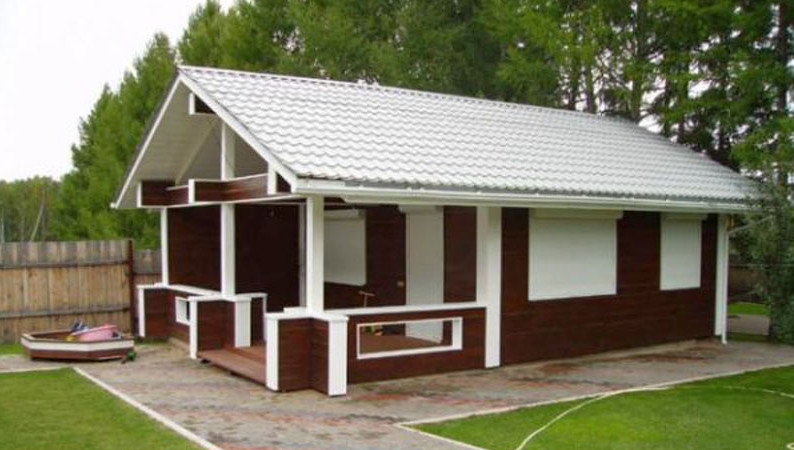 it strong, durable but heavy material. Despite the excellent sound insulation, environmental friendliness, and availability on sale, it will not work to economically build it. The laying of a deep bearing foundation will be required, the work itself is lengthy, the brick is difficult to process. Finished housing without additional measures will be characterized by insufficient energy conservation.
it strong, durable but heavy material. Despite the excellent sound insulation, environmental friendliness, and availability on sale, it will not work to economically build it. The laying of a deep bearing foundation will be required, the work itself is lengthy, the brick is difficult to process. Finished housing without additional measures will be characterized by insufficient energy conservation.
Steel structures
This is a durable and affordable material that helps to build a reliable, convenient and inexpensive house in the shortest possible time. Practice shows that the frame house is really affordable, easy to install, characterized by high load-bearing capacity against the background of light weight and universal - you can implement any project if you wish. The advantages include the possibility of arranging a unique exterior. However, additional sound, heat insulation, measures to strengthen the strength will be required.
Wood
Despite all the advantages of the material (strength, environmental friendliness, sound and heat insulation, external characteristics, etc.), it cannot be called economical. Good wood - timber, logs are available at a high cost and requires treatment measures against pests, rotting.
If it is impossible to do the construction yourself, the key to high efficiency without extra costs becomes the choice of one team responsible for the entire cycle of work
Aerated concrete, block concrete
This is a modern option that allows you to quickly and inexpensively build a good, environmentally friendly housing with high load capacity, durability, low weight. The material is easy to process, which simplifies the external and internal decoration, but requires the cost of a high-quality implementation of this stage of work.
Option for permanent residence
Choosing from a wide variety of materials, optimally stops on block concrete. Ready-made housing is suitable for living in almost any climate zone of the country, the construction technology is easy to master, which allows you to do the construction yourself. No less effective are frame houses, projects, photos and prices of which are available in a wide variety on the network.
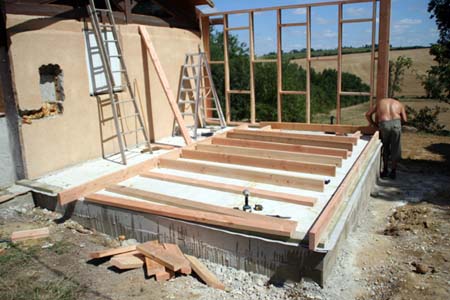 It is cheaper to implement a house project from foam blocks (or other block material) with the presented characteristics:
It is cheaper to implement a house project from foam blocks (or other block material) with the presented characteristics:
- monolithic reinforced concrete shallow foundation;
- basement and concrete blind area. Implemented by masonry in 1 brick, 250 mm;
- wall structures - gas silicate, aerated concrete, foam concrete, 300 mm;
- outer cladding - lathing, insulation, vinyl siding;
- ceilings and roofing - wooden trusses, metal profile coating on the crate, steam and water insulation, insulation, drywall;
- window constructions - wood / plastic + installation;
- interior decoration, partitions, door blocks - drywall with soundproofing, plastic panels, wallpaper;
- flooring - concrete preparation, ceramic tile, carpet, laminate;
- sewerage, water supply - PVC pipes, plumbing equipment;
- heating system - a double-circuit wall-mounted boiler, plastic pipes for hot water supply, heating, aluminum radiators;
- electrician appropriate to the design of the house.
Do not save on soil research. Even with quite prosperous neighboring areas, your own may differ in other characteristics.
That all savings did not turn into a collapse, it should Read the tips below:
- when choosing a ready-made standard project, it should be foreseen for what climatic conditions it has been developed (wind / snow load, seasonal outdoor temperatures);
- it is necessary to bind the bearing base to the soil conditions of the site. This will minimize the cost of its construction;
- if the project is selected, it is impossible to make additional changes, for example, change the material of the walls and their constructs, the size of window and door openings, the installation of additional openings, replacement of ceilings, etc .;
- do not save too much on communications. High-quality engineering systems, sewage, water supply, communications, ventilation, access roads to the site provide quality and comfort of living.
Summing up some results, it can be noted that a cheap house is not low-quality, cramped, uncomfortable housing. First of all, this is a reasonable and rational approach of the owner to the construction process and the choice of materials.
An original and original project of a house made of waste materials is presented in the video:
Recently, less and less people want to live in a cramped and stuffy city, preferring to move to their own country house. It would seem, what problems? You just need to sell an apartment and buy real estate in the country. But here is this property, alas, several times more expensive than the largest apartment.
Do not despair, there is a way out - to build a house on your own. If you understand, there is nothing complicated in building a house, the main thing is to draw up an action plan and clearly follow it.
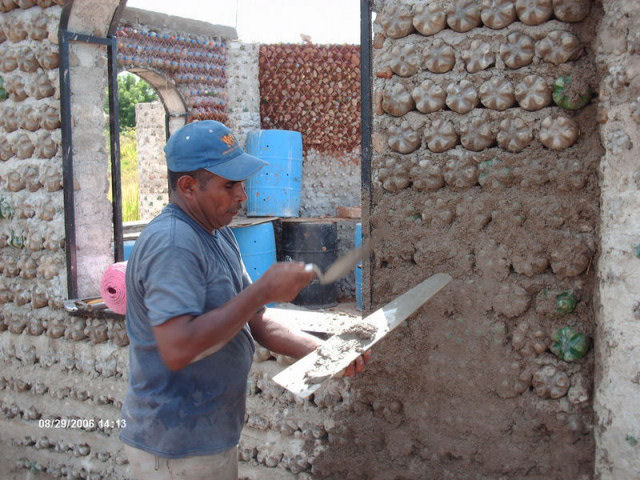

The problem of cheap housing is becoming more relevant. Many scientists worked on it, and some achieved some success. Among them, it is worth noting Berok Khoshnevisa, a professor from the United States who developed a 3D printer. This device is able to build a house with a total area of \u200b\u200b300 m² per day. Agree, not even the most experienced team is able to invest in such a period.


But it costs a 3D printer (in fact, like its operation) is very expensive, not everyone can afford it. Therefore, during construction it is more expedient to use a less expensive way to save money - to use cheap building materials.
Do it yourself cheap home: where to start?
Immediately make a reservation that unauthorized construction must be legalized and you need to arrange it as a property. To do this as quickly as possible, follow all state standards. First of all, make a competent plan of the site and the future home (it is better to entrust this matter to a qualified architect). In this regard, utilities are distributed, the method of pouring the foundation and construction Materials. With a plan in hand, you can easily bring an inexpensive home project to life.
In addition, during the preparatory work, determine the construction order. It will look something like this:
- foundation pouring;
- the construction of the "box" of the house;
- all necessary communications;
- ceiling laying;
- roof construction (preferably in autumn or spring).
Following simple technology, you can easily build a cozy inexpensive house.
Stage one: the foundation of the house
Step 1. First of all, decide what type of foundation is suitable for the soil in your area. Dig a meter hole, if the soil is sandy, clay or rocky, and there is no water at the bottom, then you can safely build a strip foundation of about 70-80 cm deep. But if there is still water, then the depth of the base should exceed 1 m.
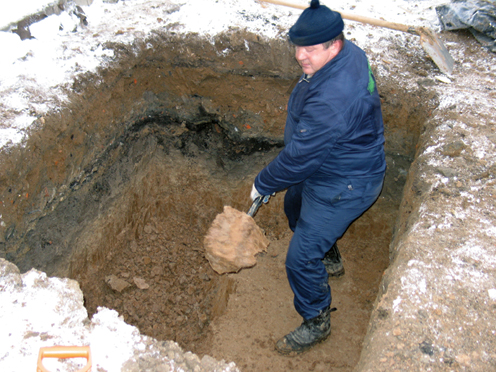

Step 2. Then remove the top layer of the earth and mark the perimeter. Focusing on the markings, dig a trench of the required depth and fill the bottom with a sand cushion.


Step 3. Build the formwork using boards or plywood. Then mix the mortar for the foundation using cement, crushed stone and coarse sand. In this case, the thicker the solution, the stronger the base (ideally, the consistency should be like that of thick sour cream). Make the width of the foundation 20 cm larger than the width of the walls. Be sure to strengthen it with metal fittings.
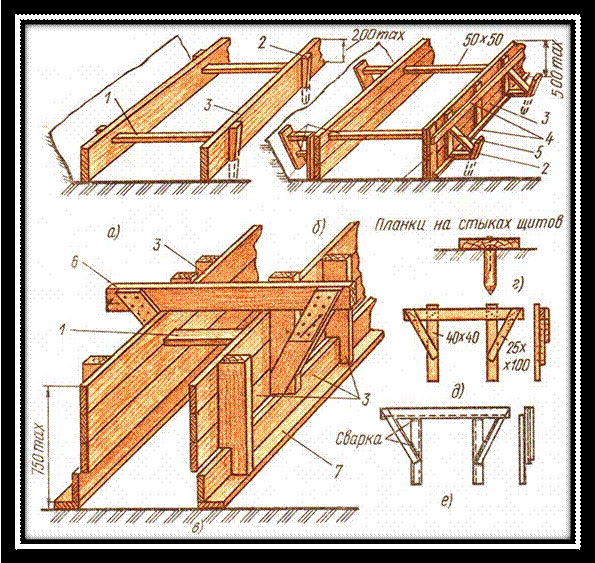

Step 4. Install a waterproofing layer - this will prevent the formation of cracks on the foundation and, therefore, increase its life. Use a roofing material for this, laying it in two layers at ground level. After that, finish the base to the required height.
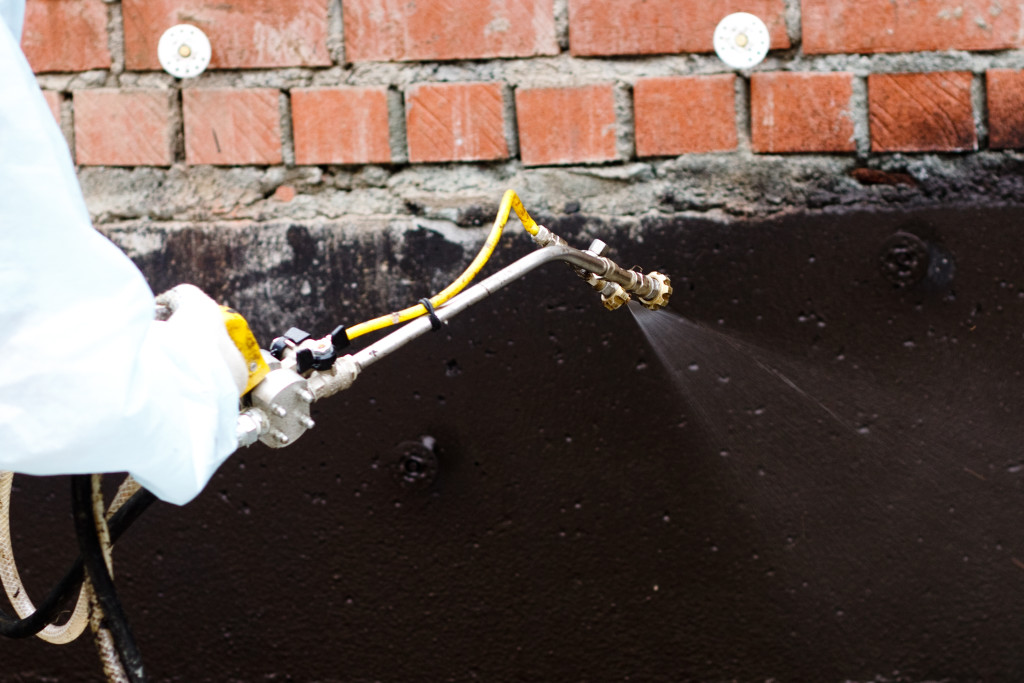

Step 5. After the insulating layer, lay the foundation with concrete blocks or brick. Make ventilation holes in two opposite walls to prevent moisture in the floor. Then give the structure a little time to dry and lay down the waterproofing (you can use any available material here).
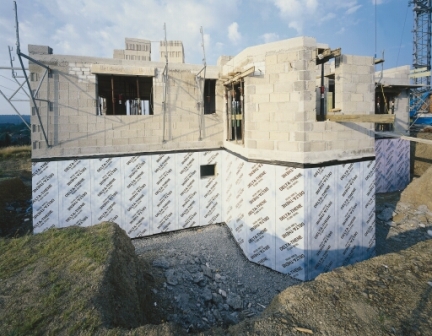

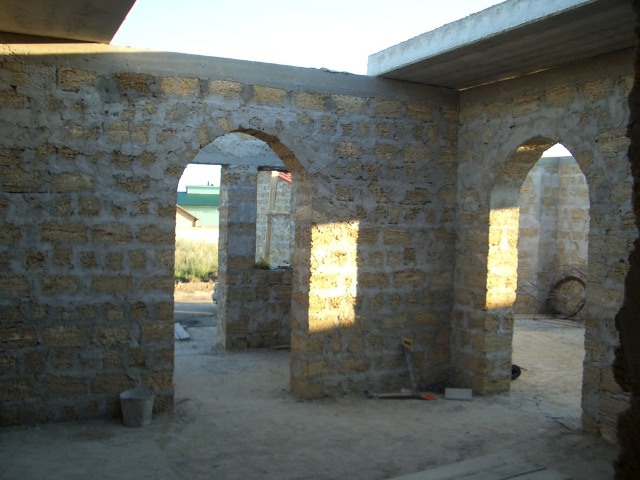

Note! The final drying and shrinkage of the foundation will occur only a few months after the construction, so do not rush to the construction of the walls.
Stage Two: Walls
There are two ways to build walls.
- A more reliable and, accordingly, expensive way is to build reinforced columns in the corners of the future home. Assemble the reinforcement rods into a “bundle”, install in the corners and fill with concrete. In this case, first you need to build wooden formwork and after that start pouring.
- If you cannot use the first method for one reason or another, then when building walls, simply reinforce them with reinforcement.
For walls, use one of the following materials:
- foam concrete;
- brick;
- shellfish;
- adobe;
- clay and glass bottles.
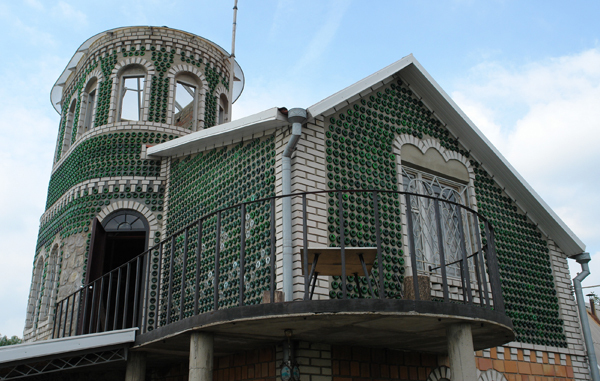

The cheapest of them is foam concrete, but it will not allow the walls to "breathe". Shellfish is more expensive, but it is it that experts recommend when building inexpensive houses. Window and doorways in this case will need to be strengthened, so equip them with metal corners.


The ready-made “box” needs to be insulated. Use glass wool and brick for this. Lay the brick on the outside of the “box” so that a small gap remains between it and the shell. Fill this gap with glass wool - such material will not only insulate the house, but also protect it from the penetration of insects and rodents.
Note! Not all partitions can use drywall or brick. In the central part of the house should always be bearing walls, built taking into account the passing communications (that is, with the places left under them).
For load-bearing partitions, use metal profiles - install them, sheathe with drywall and plaster.
Stage Three: Communication
Any house, albeit the cheapest, needs water supply, heating and other utilities. At the same time, all communications must be carried out after preliminary coordination with specialists - this will be a guarantee of safety and correct installation.
Heating
Use a gas boiler as a heat generator. This will significantly reduce heating costs, especially in winter. And in view of the fact that the cold comes mainly from the ground, give preference to “ warm floor»- make it from plastic pipes and fill it with concrete screed. So you completely heat the house, but if this does not seem enough, then spend the main heating system.
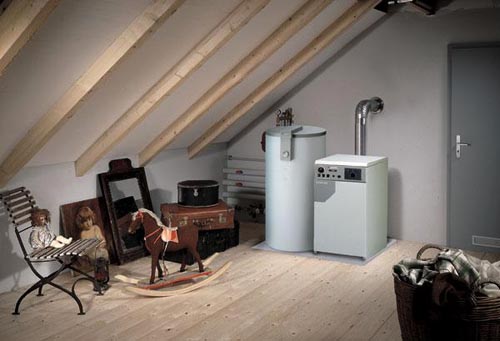

Another heating option is an alternative, based on the use of solar and wind energy. Having built a solar battery with your own hands, you will not freeze in your house even in winter.
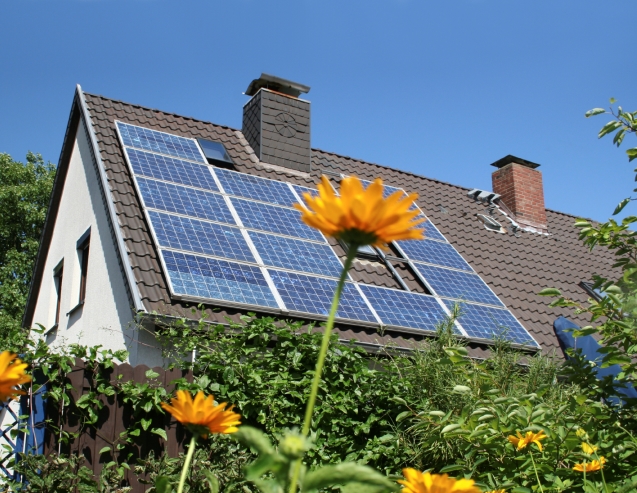

Water supply, sewer system
Lay both communications before finishing and filling the floor. Decide in advance on the location of rooms and household appliances that need a drainage system, and lay the pipes in accordance with the plan.
If the central sewerage and water supply are not available, it is worth considering the construction of a small septic tank, for example, from European cubes or concrete rings, as well as water supply. As a source of water, you can build a well or drill a well. However, the second option will hit your pocketbook hard.
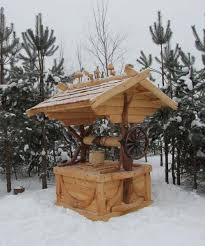

Stage Four: Floor
At the end of the installation of communications, fill the floor with a concrete screed. Then cover with any suitable material - linoleum, tile, laminate and so on. Nevertheless, it is recommended to use tiles as the most practical and damage-resistant material. It is easy to clean, and when using "warm floors" it will never be cold. Moreover, you can pick up the cheapest tile and cover it with cozy paths.


Stage Five: Roof and Ceiling
At this stage of work around the walls, build a concrete belt for attaching the beams. Then, having laid the beams, fill the bottom of the board. When building a two-story house, it is better to use concrete slabs for overlapping.
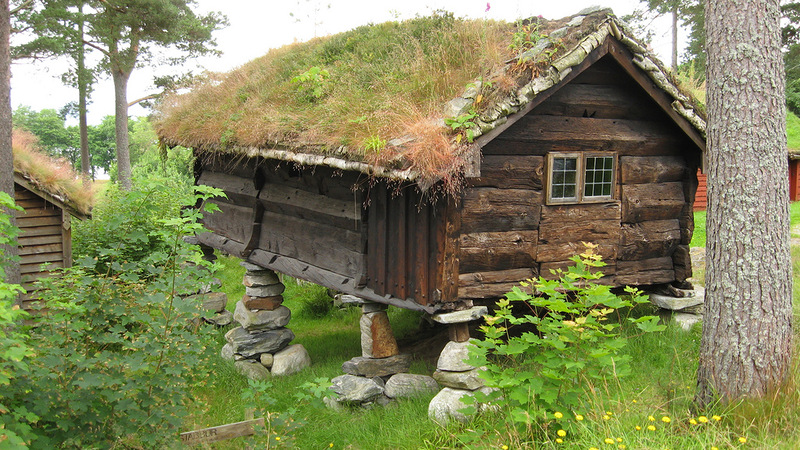

For the roof, first assemble the facing grid - this is necessary in any case, regardless of the roofing material you choose. The lattices can differ only in different step beams. It is recommended to use one of the following materials (due to financial reasons):
- ondulin;
- metal tile;
- corrugated board;
- slate.
From environmentally friendly materials, wood, straw, and reeds are applicable.
Whatever material you choose, the roof must be insulated. Use glass wool for this - this is the most affordable and easy to install material.
![]()
![]()
Completion of construction. Internal arrangement
Roof construction is the last stage of building a house. Then you can proceed to the interior decoration. There are a lot of technologies and methods of internal arrangement, almost all existing design projects can be implemented with your own hands at low cost.


In a word, it all depends only on the richness of your imagination. Stretch ceilings can be an excellent option - having a relatively low cost, they visually expand the free space with their glossy finish. They perfectly reflect light, while creating an extraordinary effect.
Also, arches and openings look good in the interior (they are easy to mount from drywall and metal profiles, or use wood and clay). Cover the walls with textured wallpaper (wallpaper “under the paint”, as they are also called), which you can make yourself. Various plasters are rather cheap. Wood finishes look great.


If you approach the matter competently and with soul, then the construction and arrangement of your own family nest will cost inexpensively. The main thing is to clearly know what you can save on and what better not to do.
What can not be saved


- Do not save on technical supervision. Read at least a thousand articles on construction, but without experience, you still will not be able to control the quality and understand the essence of construction work. Engage an engineer or experienced builder - in general, someone you would trust.
- Do not save on communications. Heating, water supply, arrivals in the yard and more - these are necessary elements of a comfortable life. Do not neglect any of the systems!
- Do not save on the project - it must be compiled by a specialist, taking into account the climatic conditions of your area. Be sure to link the project to specific building conditions. So, it often happens that the developer did not want to pay the designers to tie the foundation, after listening to the advice of the contractor (which the more expensive the better), as a result of which the foundation turned out with an excessively large margin of safety. The binding will minimize the cost of building the foundation of the house.
Also note that different people with different opinions and interests should be engaged in construction and design. This will make the right decision and avoid unnecessary costs.
